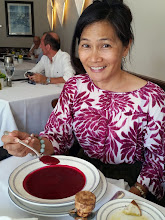In the early 1800s, Chicago was still considered the Wild West, due to its being located west of the Mississippi River. As such, the city gave rise to such innovations as the nation's railroad center during the 19th Century, Route 66, and the World's Fair of 1893. It seems fitting then that many beloved American foods like the hot dog, the brownie, and the deep dish pizza were born in Chicago. They embody a certain individuality in the United States that is woven with the common threads of sharing heritage, sharing culture, and ultimately, sharing what tastes good.
 |
Giordano's stuffed cheese deep-dish pie and High Plains Bison
dog at Wrigley Field. |
At one time, Chicago was known as the "gateway to the West." The city lived up to its name as the main corridor through which the nation's beef supply traveled. As such, Chicagoans are massive carnivores. Many of the city's best-loved dishes involve meat, including the famous Italian beef sandwich, the famous Chicago-style hot dogs (
no ketchup, ever!); and Polish sausage.
I've always wanted to visit Chicago, so when my friend Shiho said that her
Urban Sketchers symposium was going to take place there this year, I decided to tag along with my bestie for more years than either of us would probably like to admit - who also happens to be an extraordinary
artist.
Being an artist - especially the enchantress of watercolor that Shiho is - requires years of skill, a lot of patience and discipline, and the right tools. Being a foodie, at least in Chicago, only requires the willingness to walk for food. I stayed at her symposium lodgings for a couple of days, located near the Harold Washington Library and a "L" stop. We had about a ten-block orbit, with the exception of a trip to Frank Lloyd Wright's home at Oak Park and an excursion to
Eataly, the mega-food hall/cooking school/gourmet market at The Shops at North Bridge.
 |
| Cabinet for dry-aging beef at Eataly |
While it would be pretty impossible to stow a deep-dish pizza from Wrigley Field, a plate of peri-peri chicken from Nando's, or a brownie a la mode from the historic Palmer House in my luggage, the most portable foodie souvenir was this 2007 documentary on
"The Foods of Chicago." In it, one can see the gradual embracing of diverse foods from many cultures, dishes and ingredients that are now as American as apple pie, bbq ribs, and Tootsie Rolls - or dim sum, tacos, and baklava. It even explains the now defunct Curse of the Billy Goat that kept the Chicago Cubs from winning a World Series for 107 years until they triumphed over the Cleveland Indians in 2016.
I have the memories, the video, and in the case of the brownie, the
recipe.
The iconic treat that we know as the brownie today got its start as a portable but decadent dessert, served in a box lunch for ladies visiting the
Woman's Building at the World's Fair of 1893.
Bertha Honore Palmer, who with her husband Potter Palmer owned the Palmer House hotel on State Street, was one of the chief organizers of the fair and was instrumental in establishing exhibits dedicated to women's interests; she even insisted that the architect who would build the Woman's Building be selected through a competition open only to females.
 |
| The Palmer House Brownie a la mode |
Although the most popular exhibit in the Woman's Building centered on dress reform, the forward-thinking Mrs. Palmer still knew what the feminine heart desires most: chocolate. She had the hotel chefs whip up the original Palmer House brownie that is still served at the hotel today. Ironically, despite the Fair's promotion of more streamlined and healthy fashions for women, the brownie comes la mode and topped with a Florentine cookie, reminiscent of the feathered headdresses that women wore with their ballgowns in old Chicago.
Today, the brownie ranges from super-plain (no nuts for anyone under 12) to exotic flavorings like tahini. This chewy, gooey
recipe from Milk Street was like a chemistry lab, as I tried to keep the tahini in an evenly blended state. Despite that, the recipe was surprisingly easy and stunningly good.
Shiho made the observation that the Urban Sketchers Symposium - an international event - was the first time many of her fellow artists had been to the United States and that Chicago was a great city in which to experience American culture for the first time.
 |
Rainbow trout and summer squash from
Acanto's seasonal menu |
I have to agree. It's like a less crowded Manhattan. Or for this auto-weary Angeleno, a
walkable mash-up of all my favorite shopping and eating districts in
L.A., minus the attitude and road rage. And, as in any great metropolitan city, the food embodies the many cultures that inhabit the area, but with twists and tweakings that make it uniquely Chicago. American exceptionalism can't be all bad when it can taste so good.











